Unstructured Modflow Model for Numerical Simulations of Groundwater Flow in Three-Dimensional Quaternary Aquifer of Beijing Plain, China
Abstract
1. Introduction
2. Study Area
2.1. Location and Geographical Features
2.2. Geological and Hydrogeological Characteristics
3. Materials and Methods
3.1. Conceptual Hydrogeological Model
- Collection of meteorological, hydrological and borehole information.
- Generalized well data, aquifer structure generalization.
- Determination of boundary conditions and initial conditions.
- Zoning of hydrogeological parameters and determination of initial values.
- Calculation of source and sink terms.
3.1.1. Boundary Conditions
3.1.2. Hydrogeological Parameters
3.2. Calculation of Source and Sink Terms
3.3. Numerical Modeling with Unstructured Grids Use
3.3.1. Grid Layout of the Area
3.3.2. Model Calibration, Validation and Application
4. Results and Discussion
4.1. Groundwater Flow Model for the Study Area
4.1.1. Initial Conditions
4.1.2. Model Calibration
4.1.3. Model Validation
4.2. Numerical Modeling Calculations of Quartenary Groundwater in the Plain Zone
4.2.1. Groundwater Balance Analysis
4.2.2. Groundwater Level Prediction
5. Conclusions
Author Contributions
Funding
Data Availability Statement
Conflicts of Interest
References
- Hu, L.T.; Wang, Z.J.; Tian, W.; Zhao, J.S. Coupled surface water-groundwater model and its application in the arid Shiyang River basin, China. Hydrol. Process. 2009, 23, 2033–2044. [Google Scholar] [CrossRef]
- Pandian, R.S.; Nair, I.S.; Lakshmanan, E. Finite element modelling of a heavily exploited coastal aquifer for assessing the response of groundwater level to the changes in pumping and rainfall variation due to climate change. Hydrol. Res. 2016, 47, 42–60. [Google Scholar] [CrossRef]
- Xu, Y.-S.; Shen, S.-L.; Cai, Z.-Y.; Zhou, G.-Y. The state of land subsidence and prediction approaches due to groundwater withdrawal in China. Nat. Hazards 2008, 45, 123–135. [Google Scholar] [CrossRef]
- Zhou, Y.; Wang, L.; Liu, J.; Li, W.; Zheng, Y. Options of sustainable groundwater development in Beijing Plain, China. Phys. Chem. Earth Parts A/B/C 2012, 47, 99–113. [Google Scholar] [CrossRef]
- Liu, S.; Zhou, Y.; Tang, C.; McClain, M.; Wang, X.S. Assessment of alternative groundwater flow models for Beijing Plain, China. J. Hydrol. 2021, 596, 126065. [Google Scholar] [CrossRef]
- Enemark, T.; Peeters, L.J.; Mallants, D.; Batelaan, O. Hydrogeological conceptual model building and testing: A review. J. Hydrol. 2019, 569, 310–329. [Google Scholar] [CrossRef]
- Anderson, M.P.; Cherry, J.A. Using models to simulate the movement of contaminants through groundwater flow systems. C R C Crit. Rev. Environ. Sci. Technol. 1979, 9, 97–156. [Google Scholar] [CrossRef]
- Sarma, R.; Singh, S.K. Simulating contaminant transport in unsaturated and saturated groundwater zones. Water Environ. Res. 2021, 93, 1496–1509. [Google Scholar] [CrossRef]
- Seyf-Laye, A.-S.M.; Mingzhu, L.; Djanéyé-Bouindjou, G.; Fei, L.; Lyutsiya, K.; Moctar, B.L.; Honghan, C. Groundwater flow and contaminant transport modeling applications in urban area: Scopes and limitations. Environ. Sci. Pollut. Res. 2012, 19, 1981–1993. [Google Scholar] [CrossRef]
- Panday, S.; Langevin, C.D.; Niswonger, R.G.; Ibaraki, M.; Hughes, J.D. Section A Ground Water in Book Modeling Techniques. U.S. Geological Survey, MODFLOW–USG Version 1: An Unstructured Grid Version of MODFLOW for Simulating Groundwater Flow and Tightly Coupled Processes Using a Control Volume Finite-Difference Formulation; US Geological Survey: Reston, VA, USA, 2013. [Google Scholar]
- Narasimhan, T.N.; Witherspoon, P.A. An integrated finite difference method for analyzing fluid flow in porous media. Water Resour. Res. 1976, 12, 57–64. [Google Scholar] [CrossRef]
- David Krčmář, S.O. MODFLOW-USG: The New Possibilities in Mine Hydrogeology Modelling (or What is Not Written in the Manuals). Mine Water Environ. 2014, 33, 376–383. [Google Scholar] [CrossRef]
- Ezzeldin, M.; El-Alfy, K.; Abdel-Gawad, H.; Abd-Elmaboud, M. Comparison between Structured and Unstructured MODFLOW for Simulating Groundwater Flow in Three-Dimensional Multilayer Quaternary Aquifer of East Nile Delta, Egypt. Hydrol. Curr. Res. 2018, 9, 297. [Google Scholar] [CrossRef]
- Cui, W.-Z.; Hao, Q.-C.; Chen, K.; Chen, F.; Tang, S.-N.; Zhu, Y.-C.; Cao, S.-W. Comparison of Different Grid Refinement Methods in Simulations of Groundwater Recharge by Rivers. J. Earth Sci. Environ. 2020, 42, 394–404. [Google Scholar]
- Liu, S.; Zhou, Y.; Xie, M.; McClain, M.E.; Wang, X.-S. Comparative Assessment of Methods for Coupling Regional and Local Groundwater Flow Models: A Case Study in the Beijing Plain, China. Water 2021, 13, 2229. [Google Scholar] [CrossRef]
- Ji, Z.; Cui, Y.; Zhang, S.; Chao, W.; Shao, J. Evaluation of the Impact of Ecological Water Supplement on Groundwater Restoration Based on Numerical Simulation: A Case Study in the Section of Yongding River, Beijing Plain. Water 2021, 13, 3059. [Google Scholar] [CrossRef]
- Wang, L.; Gao, J.; Zou, C.; Wang, Y.; Lin, N. Water scarcity in Beijing and countermeasures to solve the problem at river basins scale. IOP Conf. Ser. Earth Environ. Sci. 2017, 94, 012132. [Google Scholar] [CrossRef]
- Sun, S.; Fu, G.; Bao, C.; Fang, C. Identifying hydro-climatic and socioeconomic forces of water scarcity through structural decomposition analysis: A case study of Beijing city. Sci. Total Environ. 2019, 687, 590–600. [Google Scholar] [CrossRef] [PubMed]
- Zeng, Z.; Liu, J.; Savenije, H.H.G. A simple approach to assess water scarcity integrating water quantity and quality. Ecol. Indic. 2013, 34, 441–449. [Google Scholar] [CrossRef]
- Zhang, S.; Wang, R.S. Water resources conservation and wastewater reuse in urban China. J. Geogr. Sci. 2010, 20, 631–648. [Google Scholar]
- Liu, J.; Yang, H.; Savenije, H.H. China’s move to higher-meat diet hits water security. Glob. Environ. Change 2015, 33, 133–141. [Google Scholar] [CrossRef]
- Wang, J.; Shang, Y.; Wang, H.; Zhao, Y.; Yin, Y. Beijing’s Water Resources: Challenges and Solutions. JAWRA J. Am. Water Resour. Assoc. 2015, 51, 614–623. [Google Scholar] [CrossRef]
- Qian, L.; Zhang, R.; Hong, M.; Wang, H.; Yang, L. A new multiple integral model for water shortage risk assessment and its application in Beijing, China. Nat. Hazards 2016, 80, 43–67. [Google Scholar] [CrossRef]
- Zhai, Y.; Wang, J.; Teng, Y.; Zuo, R. Hydrogeochemical and isotopic evidence of groundwater evolution and recharge in aquifers in Beijing Plain, China. Environ. Earth Sci. 2013, 69, 2167–2177. [Google Scholar] [CrossRef]
- Chen, B.; Gong, H.; Chen, Y.; Li, X.; Zhou, C.; Lei, K.; Zhu, L.; Duan, L.; Zhao, X. Land subsidence and its relation with groundwater aquifers in Beijing Plain of China. Sci. Total Environ. 2020, 735, 139111. [Google Scholar] [CrossRef] [PubMed]
- Zhai, Y.; Guo, Y.; Zhou, J.; Guo, N.; Wang, J.; Teng, Y. The spatio-temporal variability of annual precipitation and its local impact factors during 1724–2010 in Beijing, China. Hydrol. Process. 2014, 28, 2192–2201. [Google Scholar] [CrossRef]
- Song, X.; Zhang, J.; AghaKouchak, A.; Roy, S.S.; Xuan, Y.; Wang, G.; He, R.; Wang, X.; Liu, C. Rapid urbanization and changes in spatiotemporal characteristics of precipitation in Beijing metropolitan area. J. Geophys. Res. Atmos. 2014, 119, 11250–11271. [Google Scholar] [CrossRef]
- Beijing Municipal Water Affairs. Beijing Water Resource Bulletin 1999–2015; pp. 8–12. Available online: https://swj.beijing.gov.cn/zwgk/szygb/ (accessed on 8 August 2025).
- Wei, W. Beijing Urban Geological Atlas; China Earth Press: Beijing, China, 2008. [Google Scholar]
- Beijing Geological Survey Research Institute. Beijing Regional Geological Report; Beijing Geological Survey Research Institute: Beijing, China, 2018. [Google Scholar]
- Gao, Z. Introduction to “Geology Cloud 3.0”-National Earth Science Big Data Shared Service Platform. China Geol. 2022, 49, 2. [Google Scholar]
- Wang, L. Research on the Model of Sustainable Groundwater Utilization in Beijing Plain Area. Ph.D. Thesis, China University of Geosciences, Beijing, China, 2014. [Google Scholar]
- Wang, L.; Han, J.; Liu, J.; Ye, C.; Zheng, Y.; Wan, L.; Li, W.; Zhou, Y. Groundwater flow simulation in the Beijing Plain. Hydrogeol. Eng. Geol. 2009, 36, 11–17. [Google Scholar]
- Beijing Municipal Bureau of Geology. Groundwater in Beijing; Beijing Municipal Bureau of Geology: Beijing, China, 2008. [Google Scholar]
- Zheng, J.; Teng, Y.; Wang, J.; Hu, L. Assessment of the Groundwater Renewability in Beijing Plain Area. In Proceedings of the 2011 5th International Conference on Bioinformatics and Biomedical Engineering, Wuhan, China, 10–12 May 2011; pp. 1–4. [Google Scholar]
- Meng, S.; Fei, Y.; Zhang, Z.; Lei, T.; Qian, Y.; Li, Y. Research on spatial and temporal distribution of the precipitation infiltration amount over the past 50 years in North China Plain. Adv. Earth Sci. 2013, 28, 923–929. [Google Scholar]
- Huo, L.; Wang, B.; Pan, Z.; Wu, J.; Yang, C. Environmental impact by surface-water recharge of groundwater in Beijing Mihuaishun replenishment area—Correspondence analysis. J. Beijing Norm. Univ. (Nat. Sci.) 2020, 56, 195–203. [Google Scholar] [CrossRef]
- Zhang, D.; Zhang, Y.; Liu, L.; Li, B.; Yao, X. Numerical Simulation of Multi-Water-Source Artificial Recharge of Aquifer: A Case Study of the Mi-Huai-Shun Groundwater Reservoir. Water Resour. 2020, 47, 399–408. [Google Scholar] [CrossRef]
- Beijing Water Authority. Groundwater Dynamics in Beijing Plain District, 2021–2023. Available online: https://swj.beijing.gov.cn/so/s?qt=%E5%8C%97%E4%BA%AC%E5%B9%B3%E5%8E%9F%E5%9C%B0%E5%8C%BA%E5%9C%B0%E4%B8%8B%E6%B0%B4%E5%8A%A8%E6%80%81 (accessed on 8 August 2025).
- Zhou, Y.; Xiao, W.; Wang, J.; Zhao, Y.; Huang, Y.; Tian, J.; Chen, Y. Evaluating Spatiotemporal Variation of Groundwater Depth/Level in Beijing Plain, a Groundwater-Fed Area from 2001 to 2010. Adv. Meteorol. 2016, 2016, 8714209. [Google Scholar] [CrossRef]

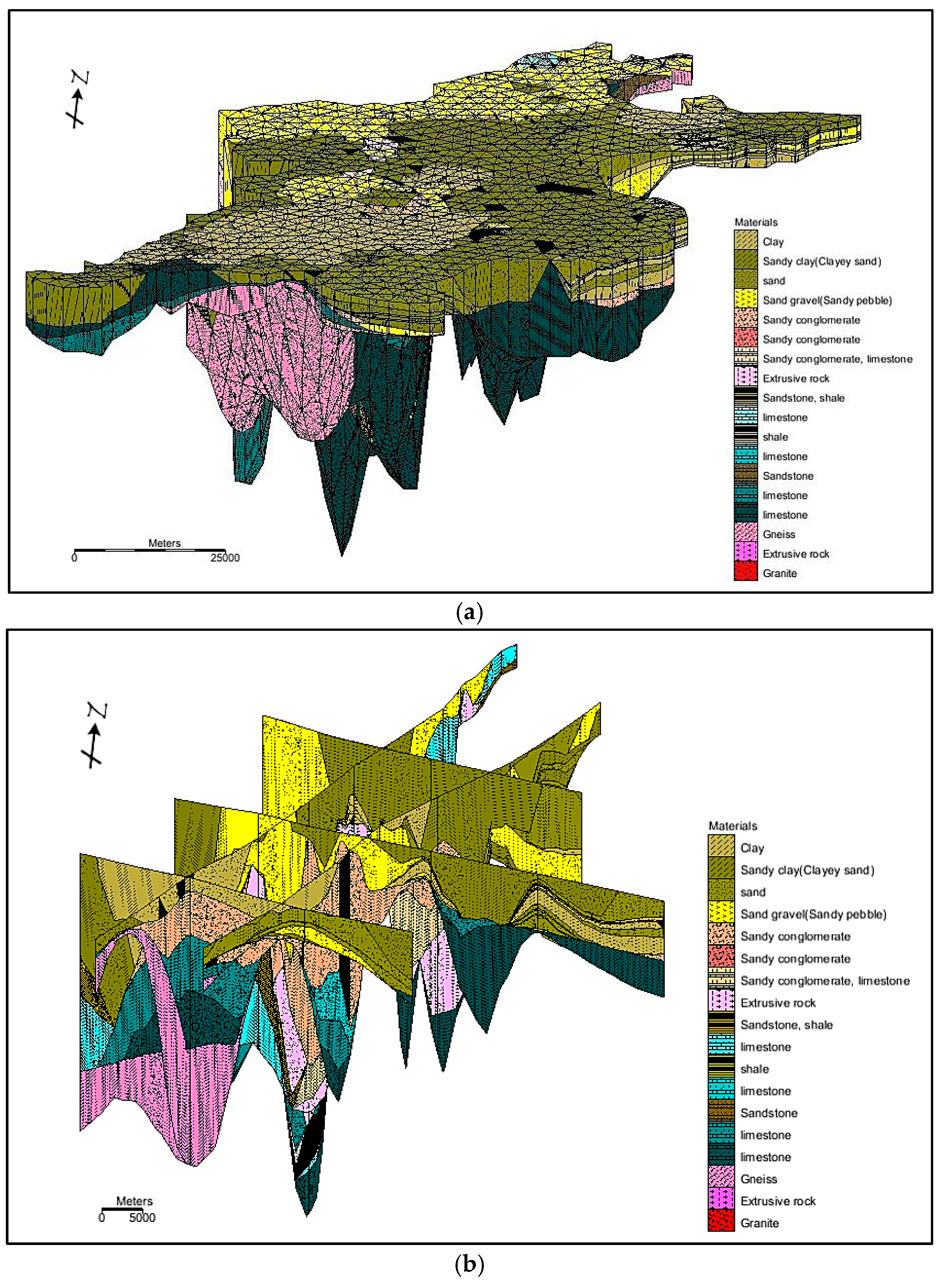
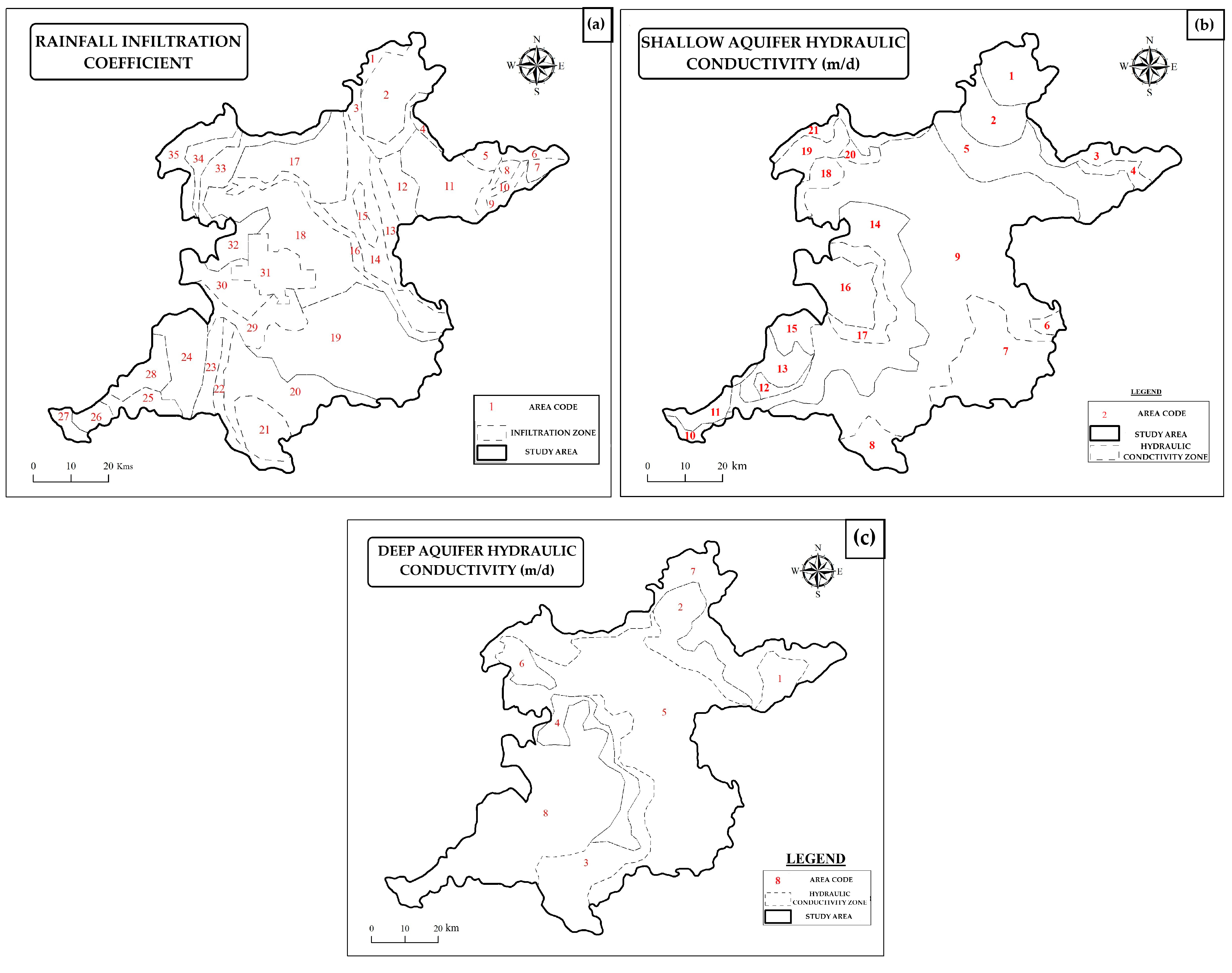
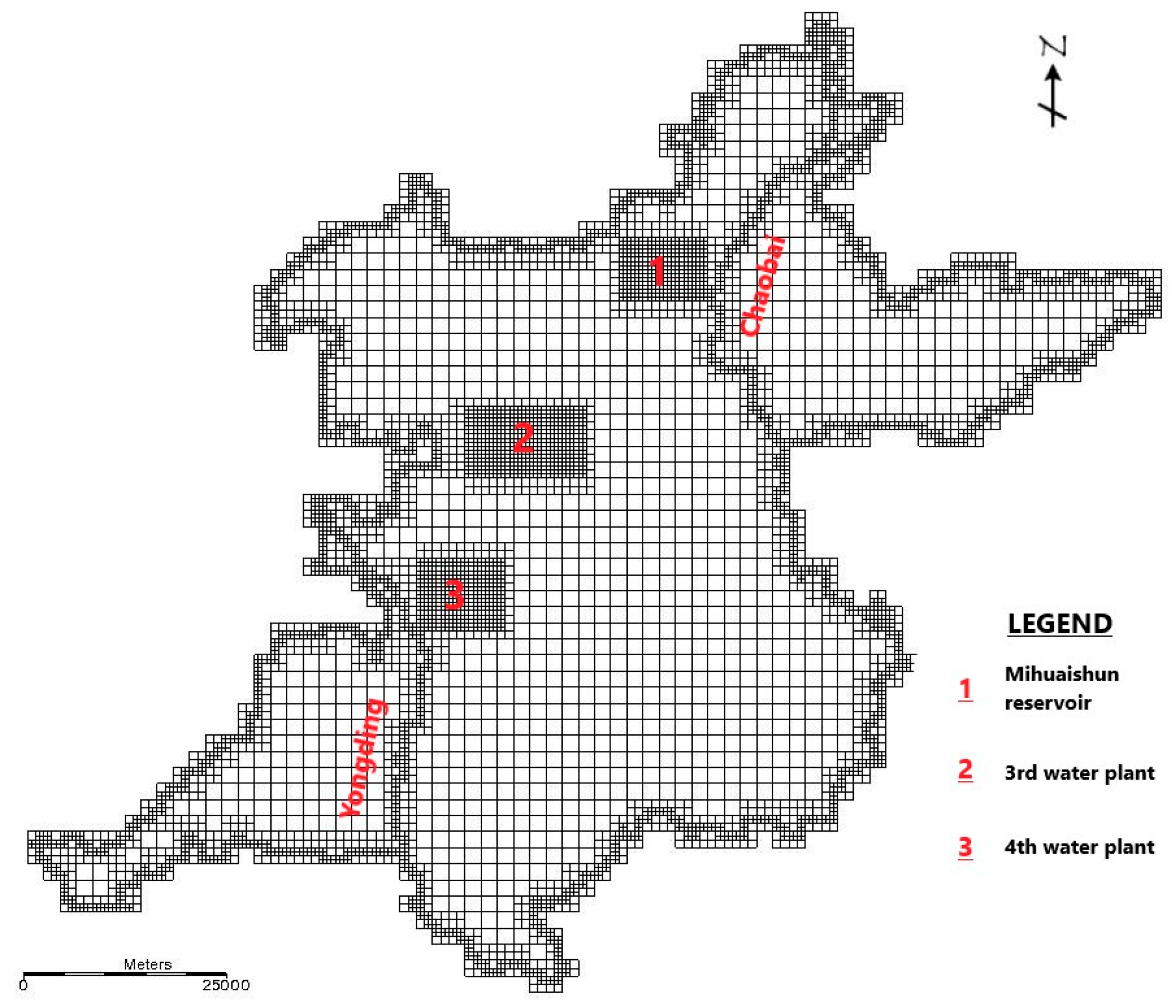

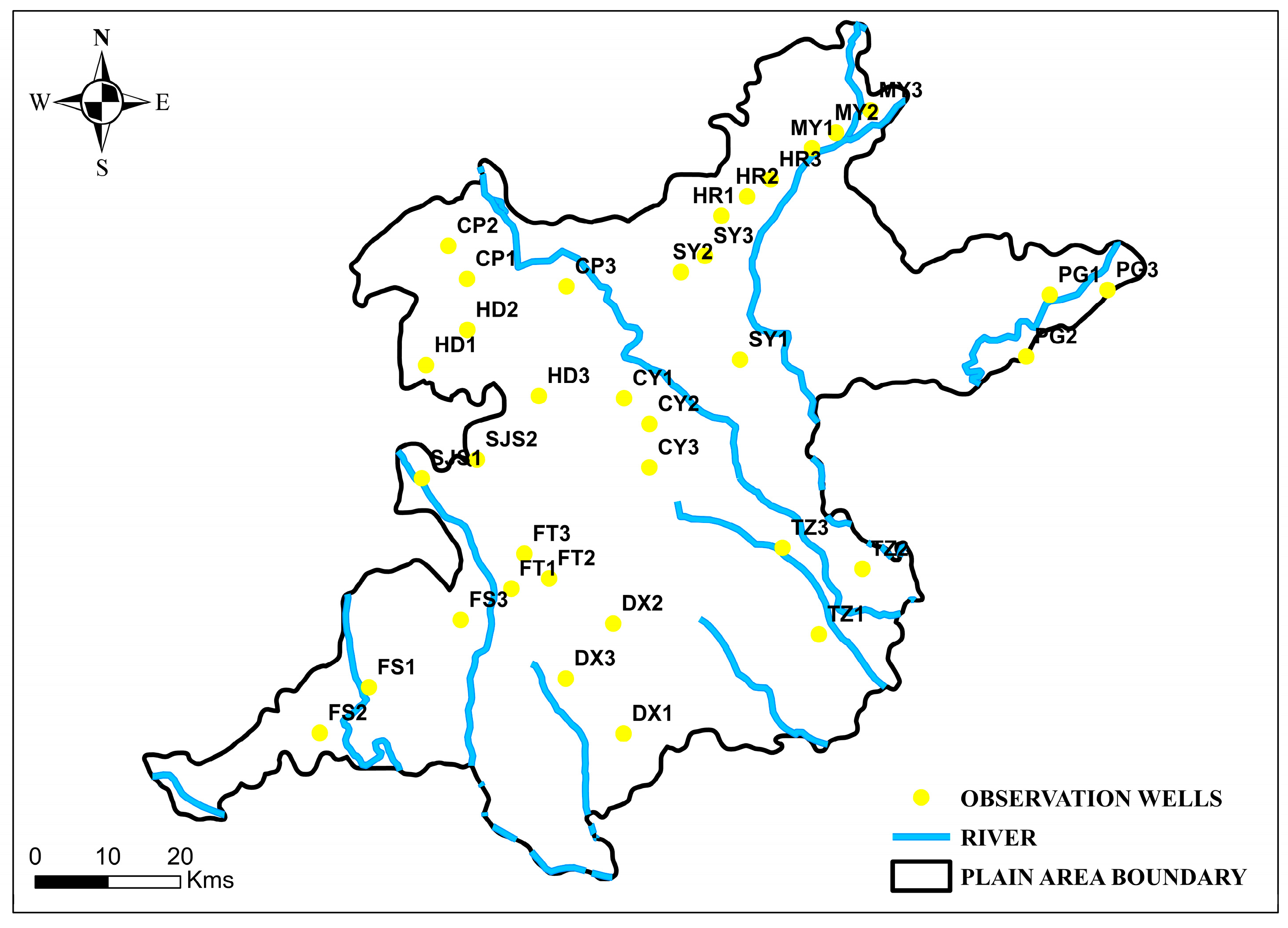



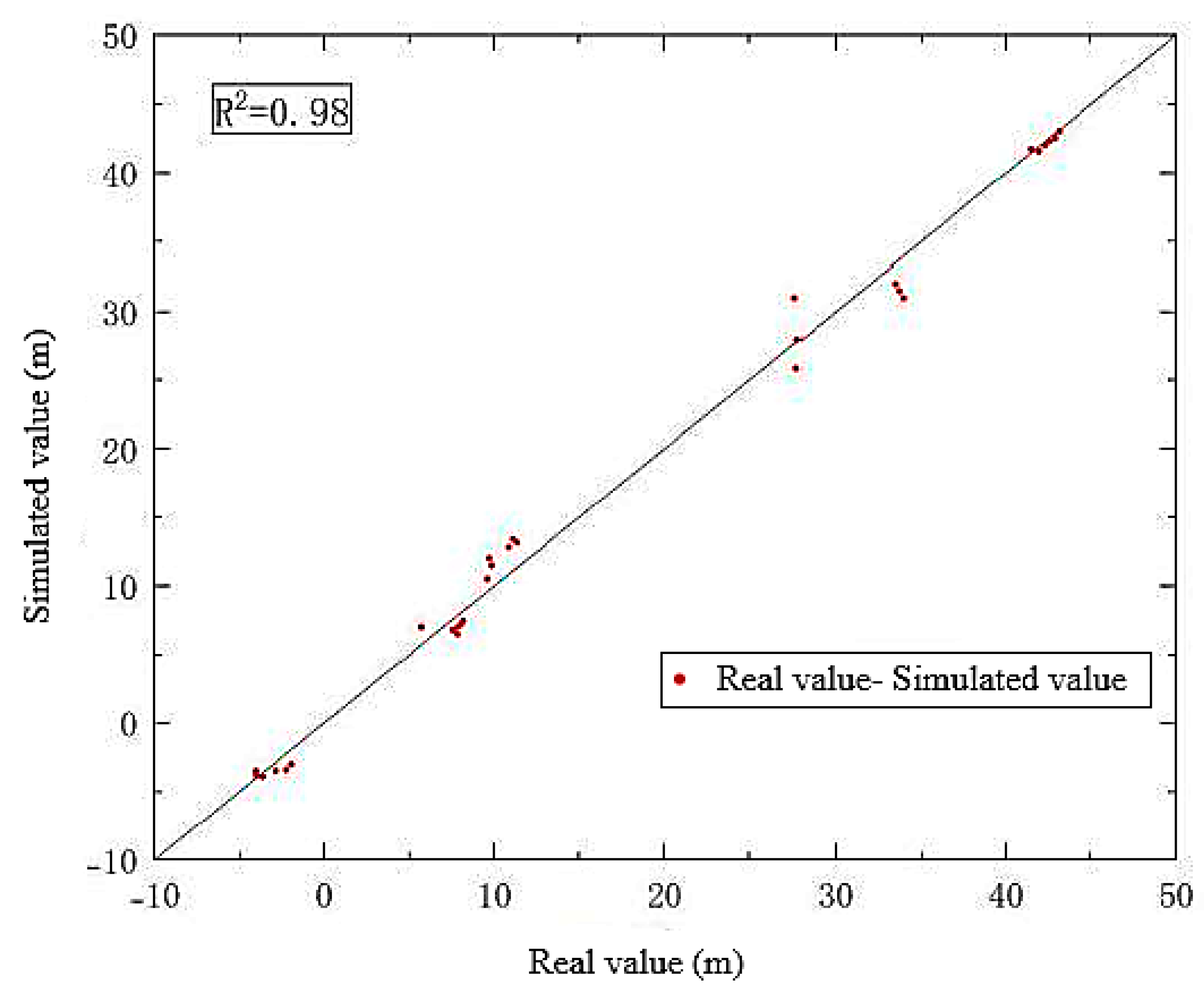

| Aquifer Type | Upper Limit (m) | Bottom Limit (m) | Use | Predominant Sediment | Recharge Mode |
|---|---|---|---|---|---|
| Shallow (unconfined) | - | 20–40 | Agriculture | Clay, fine sand and gravel |
|
| Medium (semi-confined) | 20–40 | 80–120 | Agriculture irrigation | Sandy clay | In the western part of the region, the depth of groundwater in this layer is relatively shallow and recharge is mainly provided by atmospheric precipitation gradually changing to recharge by lateral runoff in the eastern part of the region. |
| Deep (confined) | 80–120 | 180–250 to more than 300 in some areas | Domestic use | Clay, sandy clay and unsorted gravel | Lateral recharge |
| Indicative Layer | KH | KV | Ss | Indicative Layer | KH | KV | Ss | Indicative Layer | KH | KV | Ss |
|---|---|---|---|---|---|---|---|---|---|---|---|
| 1-1 | 74 | 7.4 | 0.2500 | 1-8 | 28 | 2.8 | 0.1900 | 1-15 | 62 | 6.2 | 0.2000 |
| 1-2 | 69 | 6.9 | 0.2100 | 1-9 | 60 | 15.0 | 0.2200 | 1-16 | 30 | 8.0 | 0.2000 |
| 1-3 | 50 | 12.0 | 0.1900 | 1-10 | 55 | 5.5 | 0.1800 | 1-17 | 48 | 4.8 | 0.1800 |
| 1-4 | 82 | 20.0 | 0.2500 | 1-11 | 68 | 6.8 | 0.2200 | 1-18 | 70 | 7.0 | 0.2200 |
| 1-5 | 86 | 21.0 | 0.2500 | 1-12 | 42 | 4.2 | 0.2600 | 1-19 | 43 | 4.3 | 0.1700 |
| 1-6 | 13 | 13.0 | 0.1500 | 1-13 | 16 | 1.6 | 0.2200 | 1-20 | 57 | 5.7 | 0.2300 |
| 1-7 | 23 | 12.0 | 0.2200 | 1-14 | 42 | 4.2 | 0.2100 | 1-21 | 66 | 6.6 | 0.2600 |
| 2-1 | 62 | 6.2 | 0.0025 | 2-8 | 20 | 2.0 | 0.0015 | 2-15 | 62 | 6.2 | 0.0030 |
| 2-2 | 55 | 5.5 | 0.0040 | 2-9 | 45 | 4.5 | 0.0025 | 2-16 | 30 | 3.0 | 0.0030 |
| 2-3 | 46 | 4.6 | 0.0025 | 2-10 | 52 | 5.2 | 0.0030 | 2-17 | 38 | 3.8 | 0.0030 |
| 2-4 | 60 | 6.0 | 0.0030 | 2-11 | 42 | 4.2 | 0.0025 | 2-18 | 30 | 3.0 | 0.0020 |
| 2-5 | 60 | 6.0 | 0.0030 | 2-12 | 42 | 4.2 | 0.0015 | 2-19 | 43 | 4.3 | 0.0025 |
| 2-6 | 13 | 1.3 | 0.0015 | 2-13 | 16 | 1.6 | 0.0035 | 2-20 | 33 | 3.3 | 0.0025 |
| 2-7 | 23 | 2.3 | 0.0015 | 2-14 | 36 | 3.6 | 0.0020 | 2-21 | 66 | 6.6 | 0.0025 |
| 3-1 | 40 | 4.0 | 0.0010 | 3-4 | 15 | 1.5 | 0.0015 | 3-7 | 20 | 2.0 | 0.0010 |
| 3-2 | 30 | 3.0 | 0.0010 | 3-5 | 8 | 1.0 | 0.0015 | 3-8 | 20 | 2.0 | 0.0015 |
| 3-3 | 10 | 1.0 | 0.0015 | 3-6 | 25 | 2.5 | 0.0015 |
| Area Code | Infiltration Coefficient | Area Code | Infiltration Coefficient | Area Code | Infiltration Coefficient | Area Code | Infiltration Coefficient |
|---|---|---|---|---|---|---|---|
| 1 | 0.21 | 10 | 0.45 | 19 | 0.18 | 28 | 0.15 |
| 2 | 0.34 | 11 | 0.30 | 20 | 0.39 | 29 | 0.32 |
| 3 | 0.35 | 12 | 0.37 | 21 | 0.29 | 30 | 0.19 |
| 4 | 0.18 | 13 | 0.48 | 22 | 0.51 | 31 | 0.01 |
| 5 | 0.23 | 14 | 0.41 | 23 | 0.46 | 32 | 0.28 |
| 6 | 0.20 | 15 | 0.11 | 24 | 0.41 | 33 | 0.27 |
| 7 | 0.36 | 16 | 0.41 | 25 | 0.32 | 34 | 0.24 |
| 8 | 0.25 | 17 | 0.29 | 26 | 0.28 | 35 | 0.18 |
| 9 | 0.33 | 18 | 0.25 | 27 | 0.12 |
| Source and Sinks Terms | Equation | Parameters and Units |
|---|---|---|
| Precipitation infiltration recharge | (2) | —Precipitation infiltration recharge, m3/yr; —Atmospheric precipitation infiltration recharge coefficient, dimensionless; P—Annual precipitation per unit grid, m; Z—Unit grid area, m2; |
| Lateral recharge | (3) | —lateral run recharge, m3/yr, inflow is positive, outflow is negative. K—infiltration coefficient near the aquifer section, m/d; I—hydraulic gradient perpendicular to the section, dimensionless; B—Section length, m; M—aquifer thickness, m. |
| Recharge from seepage back from irrigated farmland | (4) | —Irrigation water, infiltration recharge m3/yr; —Irrigation return coefficient, dimensionless; —Actual amount of irrigation water m3/yr. |
| Groundwater extraction | - | The extraction volume in the research area is counted in each district. The amount of extraction includes agricultural extraction, domestic and industrial extraction. Data are collected from the Beijing water resources annual report |
| Evapotranspiration | - | Recently, due to the continuous increase in exploiting groundwater, the depth of groundwater has been greater than 4 m, so the evaporative water loss from the water table is ignored in the study. |
| Type | Primary Grid | Smooth Quadtree Grid | Line Encryption |
|---|---|---|---|
| Place | General | Mihuaishun, third and fourth water plants sources | Flow area, Yongding River, Chaobai River |
| Size (m) | 2000 × 2000 | 500 × 500 | 500 × 500 |
| Well Number | Observed Value (m) | Validation Value (m) | Absolute Error/m | Relative Error | Aquifer |
|---|---|---|---|---|---|
| TZ1 | 8.18 | 7.56 | −0.62 | 7.57% | Shallow |
| TZ2 | 10.35 | 6.68 | −3.67 | 35.44% | Shallow |
| TZ3 | 12.05 | 9.60 | −2.45 | 20.34% | Shallow |
| DX1 | 11.34 | 13.14 | 1.80 | 15.90% | Shallow |
| DX2 | 18.15 | 19.70 | 1.55 | 8.54% | Shallow |
| DX3 | 17.98 | 17.14 | −0.84 | 4.67% | Shallow |
| FS1 | 28.59 | 25.17 | −3.42 | 11.96% | Shallow |
| FS2 | 27.73 | 25.81 | −1.92 | 6.92% | Shallow |
| FS3 | 36.95 | 33.95 | −3.00 | 8.11% | Shallow |
| FT1 | 36.87 | 41.91 | 5.04 | 13.67% | Shallow |
| FT2 | 29.89 | 38.52 | 8.63 | 28.86% | Shallow |
| FT3 | 34.49 | 44.30 | 9.81 | 28.43% | Shallow |
| SJS1 | 59.68 | 81.36 | 21.68 | 36.33% | Medium |
| SJS2 | 45.72 | 76.85 | 31.13 | 68.09% | Medium |
| HD1 | 41.92 | 47.14 | 5.22 | 12.45% | Medium |
| HD2 | 29.36 | 31.41 | 2.05 | 6.99% | Shallow |
| HD3 | 31.61 | 33.59 | 1.98 | 6.25% | Shallow |
| CP1 | 26.49 | 24.27 | −2.22 | 8.37% | Shallow |
| CP2 | 31.02 | 29.04 | −1.98 | 6.37% | Shallow |
| CP3 | 17.08 | 18.80 | 1.72 | 10.05% | Shallow |
| SY1 | −2.20 | −3.43 | −1.23 | 56.10% | Medium |
| SY2 | 20.95 | 22.28 | 1.33 | 6.33% | Shallow |
| SY3 | 25.52 | 22.37 | −3.15 | 12.33% | Shallow |
| HR1 | 37.15 | 34.63 | −2.52 | 6.78% | Shallow |
| HR2 | 32.46 | 28.72 | −3.74 | 11.53% | Shallow |
| HR3 | 33.57 | 32.03 | −1.54 | 4.58% | Shallow |
| MY1 | 35.92 | 32.26 | −3.66 | 10.19% | Shallow |
| MY2 | 41.47 | 41.72 | 0.25 | 0.61% | Medium |
| MY3 | 50.11 | 46.73 | −3.38 | 6.74% | Medium |
| PG1 | 10.95 | 12.37 | 1.42 | 12.99% | Shallow |
| PG2 | 12.63 | 10.20 | −2.43 | 19.21% | Shallow |
| PG3 | 20.64 | 18.06 | −2.58 | 12.49% | Shallow |
| CY1 | 6.99 | 8.21 | 1.22 | 17.42% | Shallow |
| CY2 | 3.45 | 2.83 | −0.62 | 18.11% | Shallow |
| CY3 | 11.03 | 7.38 | −3.65 | 33.09% | Shallow |
| Inflows | Outflows | ||
|---|---|---|---|
| Precipitation infiltration amount | 10.21 | ||
| Lateral inflow | 6.02 | Lateral outflow | 1.58 |
| River infiltration amount | 3.69 | Artificial mining | 14.78 |
| Irrigation replenishment amount | 1.07 | ||
| Total | 20.99 | 16.36 | |
| Balance | 4.63 | ||
Disclaimer/Publisher’s Note: The statements, opinions and data contained in all publications are solely those of the individual author(s) and contributor(s) and not of MDPI and/or the editor(s). MDPI and/or the editor(s) disclaim responsibility for any injury to people or property resulting from any ideas, methods, instructions or products referred to in the content. |
© 2025 by the authors. Licensee MDPI, Basel, Switzerland. This article is an open access article distributed under the terms and conditions of the Creative Commons Attribution (CC BY) license (https://creativecommons.org/licenses/by/4.0/).
Share and Cite
Camara, S.F.; Zhou, J.; Zhang, Y. Unstructured Modflow Model for Numerical Simulations of Groundwater Flow in Three-Dimensional Quaternary Aquifer of Beijing Plain, China. Water 2025, 17, 3162. https://doi.org/10.3390/w17213162
Camara SF, Zhou J, Zhang Y. Unstructured Modflow Model for Numerical Simulations of Groundwater Flow in Three-Dimensional Quaternary Aquifer of Beijing Plain, China. Water. 2025; 17(21):3162. https://doi.org/10.3390/w17213162
Chicago/Turabian StyleCamara, Sarah Fatim, Jinjun Zhou, and Yongxiang Zhang. 2025. "Unstructured Modflow Model for Numerical Simulations of Groundwater Flow in Three-Dimensional Quaternary Aquifer of Beijing Plain, China" Water 17, no. 21: 3162. https://doi.org/10.3390/w17213162
APA StyleCamara, S. F., Zhou, J., & Zhang, Y. (2025). Unstructured Modflow Model for Numerical Simulations of Groundwater Flow in Three-Dimensional Quaternary Aquifer of Beijing Plain, China. Water, 17(21), 3162. https://doi.org/10.3390/w17213162







